Franz Cells are individually hand blown diffusion cells made of two borosilicate glass components. The upper part may be called the cell cap, cell top, donor chamber, or donor compartment. The lower portion is generally called the body of the cell, sometimes it is referred to as the receptor chamber but in the case of jacketed cells this is misleading as the receptor chamber is the innermost portion of the cell.
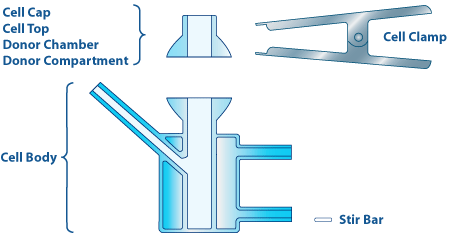
The upper surface of the cell body and the mating lower surface of the donor chamber are together known as the joint. The membrane through which the permeation or transport is being studied is placed in the middle of the joint and held in place with a clamp.
The orifice of a Franz Cell is the area to which the donor and receptor chambers are exposed. In the case of blown glass diffusion cells this area is circular. When referring to a Franz Cell, the size of the cell is the orifice diameter of the joint at the mating surface and is not the outer diameter of the joint.
There are presently four varieties of joints available for Franz Cells: flat ground, flat flange, o-ring, and spherical or corneal. Please refer to the pictures below. The most popular joint is the flat ground variety, which is sometimes called a flat ground o-ring joint. This joint is stronger than the flat flange joint of the same orifice diameter and is useful for almost any membrane thinner than 4mm. Flat flange joints have clamps which allow membranes or devices up to about 10mm in thickness and even 30mm with longer screws. O-ring joints are generally used for thin synthetic membranes that the user wishes to hold over the top of the receptor chamber using the o-ring to compress the membrane. Some users also hold skin in place with o-ring joints. We also have Nail Adapters that allow fingernail or toenail specimens to be placed in both Franz Cells and Side-Bi-Side Cells.
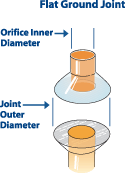
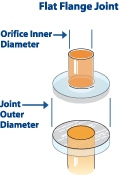
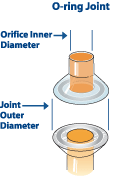
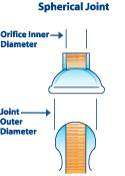
Spherical joints are used for corneal work and presently there are two sizes available with ball diameters of 12mm and 18mm.
As previously stated, the orifice diameter is referred to when describing the size of a Franz Cell. If the receptor chambers were always cylindrical, excepting the sampling arm, receptor chamber volumes would always be the same for a given orifice diameter. However, studies often require different volumes and we make Franz Cells with different receptor chamber volumes while maintaining the standard Franz Cell height.
The two drawings below are approximations of 5mm jacketed Franz Cells. The cell to the left is our standard cell which has a 5ml volume. Notice that the receptor chamber diameter is larger inside the heating jacket. This is to provide the 5ml volume that many researchers prefer. The cell on the right is also a 5mm cell and the receptor chamber diameter continues almost all the way to the bottom of the cell where a bulb shaped volume exists for the purpose of making room for a stirbar. The receptor chamber volume of this jacketed cell is about 3ml and is the smallest we can make in a jacketed cell.

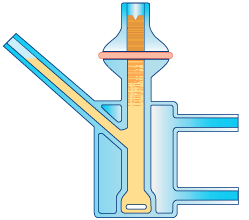
The two drawings below like those above illustrate that it is possible to have different receptor chamber volumes for jacketed cells having the same orifice diameter. The cell on the left approximates the dimensions of a standard 9mm cell. The cell on the right is identical except that the bottom of the receptor chamber has been shortened to lessen the receptor chamber volume. The height of the hollow volume in the bottom of the cell can only be 1cm to ensure that the stirbar is still rotated by the driving magnets in our stirrers.
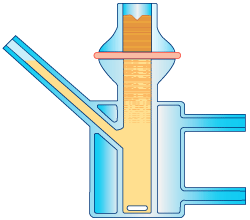
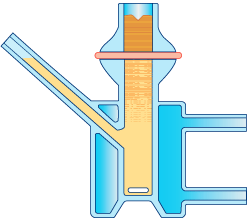
Once again, the two drawings below illustrate different ways to change the receptor chamber volume of a jacketed Franz Cell. The lefthand drawing approximates a 15mm cell with a cylindrical receptor chamber of 12ml. The righthand drawing shows a 20mm cell having a receptor chamber of reduced diameter and height, in this case the same size as a 15mm cell, inside the heating jacket. Our standard 20mm cells have 15ml receptor volumes, but the one shown is approximately 12ml like the 15mm cell.
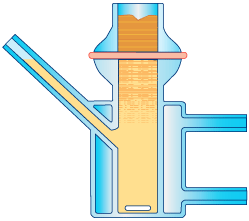
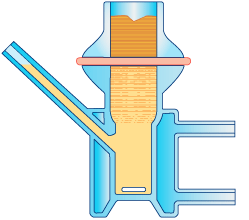
Jacketed cells may be connected to a water source for temperature control. Unjacketed cells may be placed in a dry block heater, water bath, or temperature controlled environment if needed. The receptor chambers and the jackets are hand blown together at the same time and cannot be separated. Heating jackets cannot be added to previously manufactured unjacketed cells.

Jacketed cells are more popular even though they are more expensive. This may be because users feel that temperature control is more dependable with jacketed cells or because water baths and circulators are more common in laboratories and therefore the dry block heaters or controlled environments need not be purchased.
The heating jackets of all Franz Cells are the same diameter regardless of their orifice size. Therefore, all jacketed Franz Cells will fit into all PermeGear, Crown Glass and most other stirrers even though their orifice diameters and joint varieties may vary greatly. The drawings below are of the lower portions of four different jacketed cells with receptor chamber diameters ranging from 5mm to 25mm. These drawings show that no matter what the receptor chamber diameter, the heating jacket outer diameter is always 30mm. Bear in mind that the 30mm is the outer diameter of the tubing as it is supplied by Corning or other tubing manufacturers. That diameter is subject to tolerances beyond our control. However, the cell holders on our stirrers and the spring on our Cell Stands, were designed to accommodate standard deviations from the 30mm outer diameter norm.

Jacketed cells are intended to be used in V-Series Stirrers. Unjacketed cells may be used without temperature control if only stirring is required, and if the user supplies a means to support the unjacketed cells in the centers of the stirrer’s cell holders.
Franz Cells, jacketed or unjacketed, when assembled with a clamp, cannot generally stand up by themselves because of the weight of the clamp. If the user is purchasing a V-Series Stirrer the cells will be held in place by the Plexiglas or aluminum cell holders on the unit. If only one cell is to be used, a PermeGear Cell Stand may be purchased, or the researcher can use laboratory hardware or other means to support the cell. The lefthand drawing below is of a 9mm jacketed Franz Cell with a flat ground, but no clamp, in a PermeGear Cell Stand. Any jacketed cell will fit into one of our Cell Stands. The righthand drawing shows a 9mm unjacketed Franz Cell with a flat flange joint, again without a clamp. An easy way to make a support for an unjacketed cell is merely to cut a hole in a piece of styrofoam as shown.
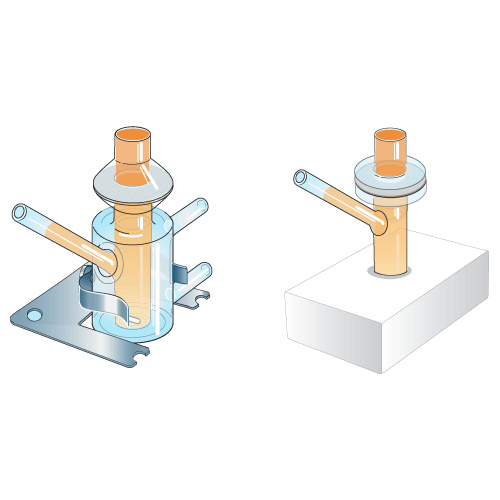
If only one Franz Cell is to be used, a common laboratory stirrer can usually spin the stirbar in the receptor chamber of the cell. Sometimes it is possible to mix the contents of the receptor chambers in more than one cell with a single stirplate but usually it doesn’t work because the center of the driving magnet is not directly below the magnets of the multiple cells attempting to be stirred.
The sampling arm, heating jacket inlet and outlet tubes, and optional flow porting of standard Franz Cells are all made from 6mm O.D. tubing that has a 1.0mm wall thickness. Given the tolerances of the tubing as dictated by the manufacturer of the tubing itself, the inner diameter of the tubing is about 4mm. Syringes with 2mm O.D. needles can easily be used to sample Franz Cells. The sampling arm volume of standard Franz Cells is unstirred volume and should be kept as small as possible.
The discussion regarding the location of the calibration mark on the sampling arm of a Franz Cell is controversial, always lively, and probably worth a web page by itself. PermeGear’s position is this: When filling a standard PermeGear Franz Cell receptor chamber to the line on the sampling arm, the volume required is the number of milliliters etched onto the sampling arm next to the calibration mark. We try to hold the volumes of the smaller varieties to +/-.2ml from the standard and the larger sizes to +/-.5ml.
There are various considerations as to why our cell receptor chamber volumes are not held to tighter tolerances. First, the individual handblown components of Franz Cells, jacketed or unjacketed, are created from glass tubing or glass components that are supplied by major glass manufacturers. These components themselves vary in diameter and wall thickness more than one might expect. Furthermore, these components are measured and made manually and no exacting machine tools are involved. They are, however, made with great care and when complete they are fused together to create a complete cell. The resulting volume for a Franz Cell of any given orifice diameter is a result of the handwork in making the individual components as well as the fusing and sealing operations to complete the cell. Because these are all manual operations, deviations from the ideal standard volume will occur. The final volume for a Franz Cell’s receptor is determined by filling it with a pipette until the meniscus is neither concave nor convex but approximately flat with the plane of the joint. At that time, the volume of water pipetted into the cell is noted and a mark is made on the arm of the cell and the volume etched next to it accurate to .1ml. It is important to note that capillary action will draw the water in the sampling arm to a level higher than the plane of the joint. If the standard volume of water cannot fit into the receptor body without the meniscus becoming convex then the volume at the calibration will be smaller than the standard volume. If more than the standard cell volume is required for the meniscus to be flat and flush with the plane of the joint surface, then the measured volume is larger than the standard.
There are other manufacturers who hold Franz Cell receptor volumes extremely closely. We feel that the variations in most biological membranes are in themselves so great that the cost of achieving extremely close receptor volumes is not justified.
Two horizontal pairs of cells are show below. The upper pair shows two completely assembled Franz Cells and the lower pair shows the same cells without the membranes or clamps for clarity. In both drawings the lefthand image shows how are standard cells look when filled to the volume etched below the calibration mark. The righthand images show what those same cells would look like if the calibration mark is in the same plane as the joint surface. Remember that when we make our cells the fluid in the sampling arm rises to its own level if the receptor volume is filled so that the meniscus is approximately flat and even with the joint surface. Some researchers have a concern that the higher level of the receptor fluid in sampling arm may cause upward pressure on the membrane when the cell is assembled. We believe that since that level is naturally occuring as a result of capillary action that there is no pressure on the membrane.
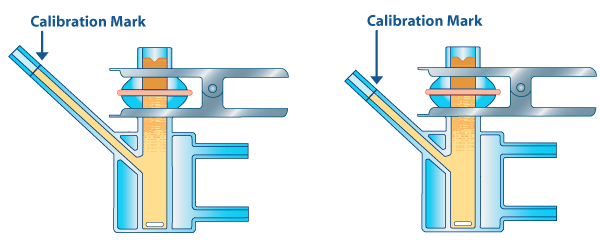
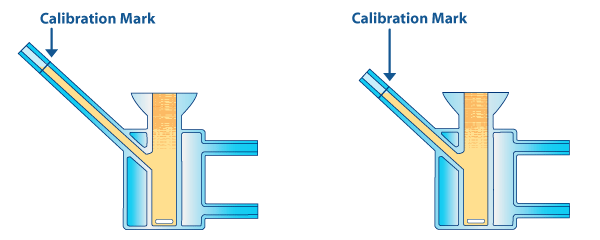
PermeGear V-Series Stirrers are for jacketed Franz Cells and are available in 3, 6 and 9 cell models. Aside from the number of cells that the stirrers may hold, the user must take into consideration the center-to-center distance of the cells when ordering a stirrer. The V3 stirrer that holds 3 cells and the V9 stirrer that holds 9 cells locate the cells 5 inches or 127 millimeters from the center of one cell to the center of the next. The V9-C Stirrer also holds 9 cells but the center-to-center distance is 2.6 inches or 66 millimeters. In the case of the larger 25mm Franz Cells whose flat flange clamps are 65mm wide, handling the cells may be cumbersome. In the case of the 30mm Franz Cells whose flat flange clamps are 71mm wide, placing the cells in the cell holders is not possible.
Download the PermeGear guide to Standard Franz Cell Dimensions

